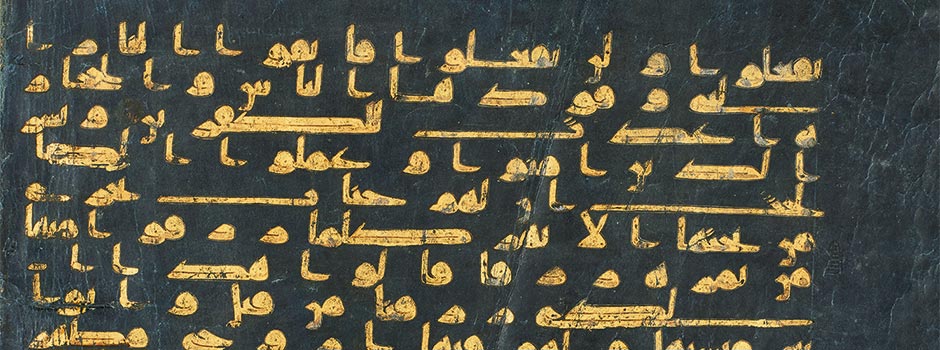
Auction at Sotheby’s London (October 23, 2019) 1000 Years of Art Across the Islamic and Indian World
Oct 06, 2019 EVENT, Art Auction

Benedict Carter, Sotheby’s Islamic Art specialist and Head of Sale, said: “Spanning several continents and centuries – with the earliest pieces stretching back to the seventh century – the selection showcases masterpieces of calligraphy, painting, ceramics, metalwork, jewellery and furniture. Viewed together, it is an undeniable testament to the sophisticated, inventive and diverse output of the Islamic world. Alongside our biannual sale, we are also thrilled to be presenting a stand-alone single-owner auction of just under a hundred manuscripts put together by a distinguished collector with an expert eye and eclectic taste.â€
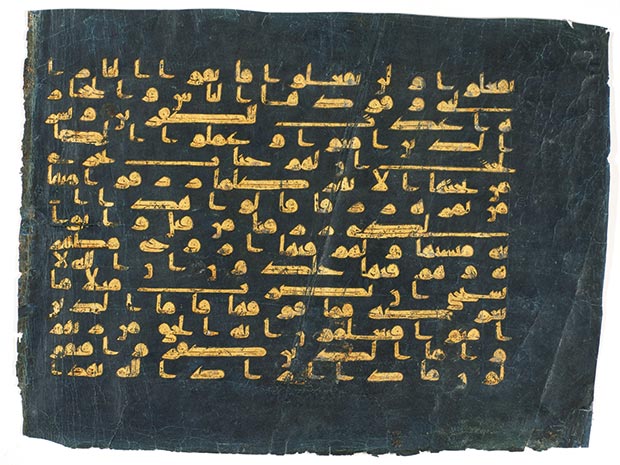 A large Qur’an leaf in gold Kufic script on blue vellum, Near East, North Africa or Southern Spain, 9th-10th century AD / Courtesy of Sotheby's
A large Qur’an leaf in gold Kufic script on blue vellum, Near East, North Africa or Southern Spain, 9th-10th century AD / Courtesy of Sotheby's
This rare leaf is from an extraordinary manuscript referred to as the ‘Blue Qur’an’, which when complete must have been one of the most startlingly luxurious manuscripts produced in the medieval Arab world. While the exact geographical origins and story of the commission behind the manuscript remain elusive, it is universally agreed that the now enigmatic patron must have been a ruler of enormous wealth and ambition – the strikingly opulent dyed blue vellum and gold script sent a bold socio-political message to neighbouring empires.
The auction offers three previously unknown illustrations from the first illustrated royal copy of the Akbarnama – the official chronicle of Akbar’s reign, begun on the Mughal Emperor’s own orders in 1589. An important addition to the manuscript – 116 illustrations from which are held in the Victoria and Albert Museum – these pages record events in 1548, 1557 and 1574.
_Akbarnama_India_Mughal_ca1590-95.jpg) Akbar and his entourage journey by boat, illustrated page from the ‘First’ (Victoria and Albert Museum) Akbarnama, India, Mughal, circa 1590-95 / Courtesy of Sotheby's
Akbar and his entourage journey by boat, illustrated page from the ‘First’ (Victoria and Albert Museum) Akbarnama, India, Mughal, circa 1590-95 / Courtesy of Sotheby's
This episode relates to Akbar’s journey to the Eastern Provinces by boat in 1574, an expedition undertaken in order to quell a rebellion. Amidst the choppy water, Akbar himself is seated under a canopy in the central boat, which is elaborately designed with a dragon-head prow.
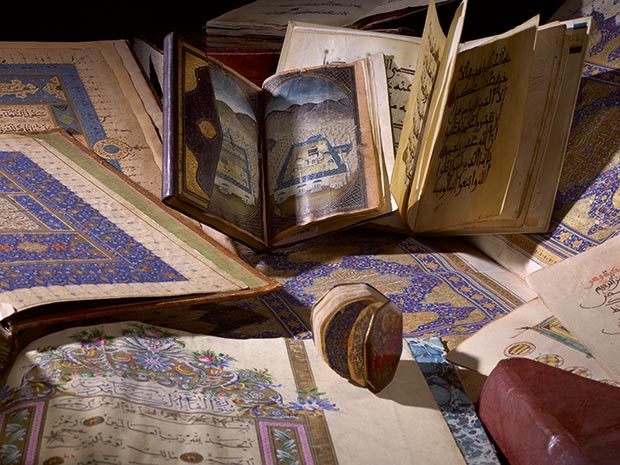 The Shakerine Collection / Courtesy of Sotheby's
The Shakerine Collection / Courtesy of Sotheby's
Formed over fifty years of dedication and passion, this exceptional collection of ninety-four manuscripts has at its heart the very best of calligraphy and illumination. With a remarkable range of religious and secular works, comprising examples from Turkey, India, Persia and the Arab World, it charts over a millennium of fine manuscript production. The refined eye and cosmopolitan taste of the collector – whose collection also encompasses works by Renoir, Van Gogh, Gauguin, Rodin and Man Ray among others – shines through.
The title for the collection was inspired by the architecturally striking Şakirin Mosque in Istanbul – the first mosque designed by a woman. The interior of the modern mosque is lined with verses from the Qur’an commissioned by contemporary calligraphers, which eloquently bears witness to the primacy of the written word in Islamic civilisation.
_Egypt_Mamluk_14-15th-century.jpg) An illuminated Qur’an juz (V), Egypt, Mamluk, 14th-15th century / Courtesy of Sotheby's
An illuminated Qur’an juz (V), Egypt, Mamluk, 14th-15th century / Courtesy of Sotheby's
.jpg) An illuminated Qur’an, copied by Mehmed Rashid knows as Hafiz al-Qur’an and illuminated by Hasan al-Hilmi Turkey, Ottoman, dated 1259 AH1843-44 AD / Courtesy of Sotheby's
An illuminated Qur’an, copied by Mehmed Rashid knows as Hafiz al-Qur’an and illuminated by Hasan al-Hilmi Turkey, Ottoman, dated 1259 AH1843-44 AD / Courtesy of Sotheby's
 A monumental illuminated Safavid Qur’an, mid-16th century Persia / Courtesy of Sotheby's
A monumental illuminated Safavid Qur’an, mid-16th century Persia / Courtesy of Sotheby's
One of the finest Qur’ans to have been offered at auction in decades, this magnificent lavishly illuminated and colourful manuscript bears all the hallmarks of the most refined pieces of the Safavid period – and is indeed one of the largest Safavid Qur’ans to have survived today. Thought to have been a royal patronage or noble commission, it was exhibited as part of the Exhibition of Persian Art at The Iranian Institute in New York in 1940, and then went on loan to Harvard University’s Fogg Museum of Art in Boston.
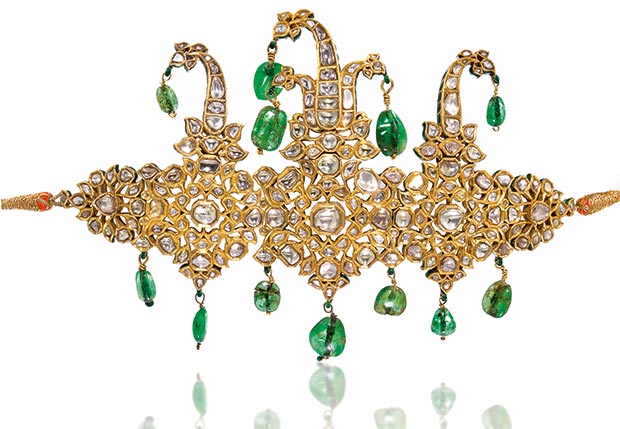 A gem-set gold and enamelled sarpech, India, Benares, circa 1850 / Courtesy of Sotheby's
A gem-set gold and enamelled sarpech, India, Benares, circa 1850 / Courtesy of Sotheby's
Only the Mughal Emperor, his intimate relations and select members of his entourage were permitted to wear a royal turban ornament, and this triple sarpech is a particularly elaborate example. During the reign of Shah Jahan, an ornate jewelled brooch took the place of the heron feather in the turban, yet this example retains a stem for the insertion of the original feathered plume.
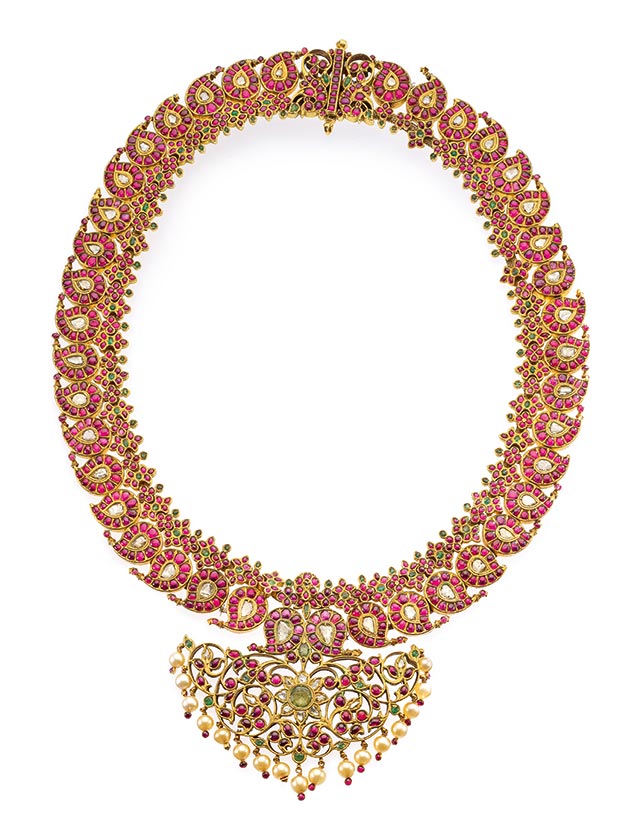 A diamond, ruby and emerald-set gold Manga Malai necklace, India, 19th century / Courtesy of Sotheby's
A diamond, ruby and emerald-set gold Manga Malai necklace, India, 19th century / Courtesy of Sotheby's
The southern part of India is renowned for its fine golden jewellery, and pieces like this were traditionally worn for special occasions such as rituals or weddings. The Manga Malai – which directly translates to ‘necklace of mangoes’ – is unique to the ancient Tamil people, dating back to the thirteenth century. According to Hindu mythology, the mango fruit is a symbol of love and fertility, and the principal elements of the design represent nature, with various forms of flowers, leaves, fruits and buds.
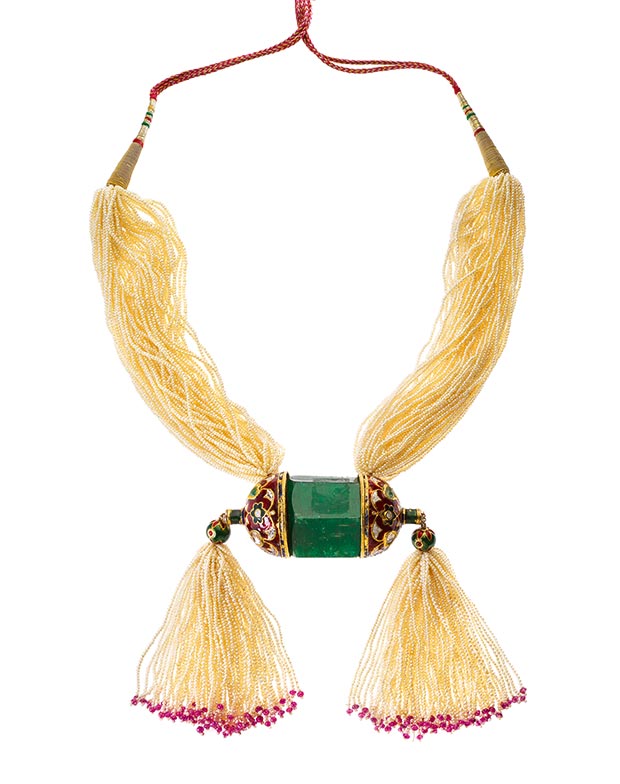 A 363.9 carat Mughal emerald crystal set in enamelled mount with seed-pearl string necklace, North India, 18th century / Courtesy of Sotheby's
A 363.9 carat Mughal emerald crystal set in enamelled mount with seed-pearl string necklace, North India, 18th century / Courtesy of Sotheby's
In Mughal India, emeralds were associated with fertility and were believed to aid good vision. During this period, such gemstones were mined in Columbia and reached India via Spanish merchants as trade goods and a strong relationship was forged, with the Mughals purchasing the largest and finest quality emeralds. This necklace is a rare example of an emerald being mounted in its crystalline form, in order to flaunt its size.
This superb Ottoman brocaded silk, in almost pristine condition and with a distinguished provenance, having once been in the collection of Edmund de Rothschild, showcases the very best of the magnificent workmanship and historic ceremonial significance of these sophisticated Ottoman courtly textiles. The design consists of a floral decoration in a pattern of roses, carnations and palmettes, which also formed the basis of inspiration for Iznik ceramics. Valuable textiles made of luxury materials formed an essential part of Ottoman ceremonies, such as the accession of sultans, parades and receptions. They appeared in the forms of banners, costumes, curtains, wall-hangings and ground-coverings – which lent visual magnificence – and as ‘robes of honour’ bestowed on foreign diplomats and court servants, serving to represent the Sultan’s generosity and power. This striking dish depicts a stylised lion form walking within a lush vegetal landscape. Inspired by imported Chinese Ming period porcelain wares, the Safavid craftsmen have introduced a more patterned approach to the design, taking the Chinese naturalistic elements and transforming them into decorative patterns. The auction will take place on 23 October at Sotheby’s London.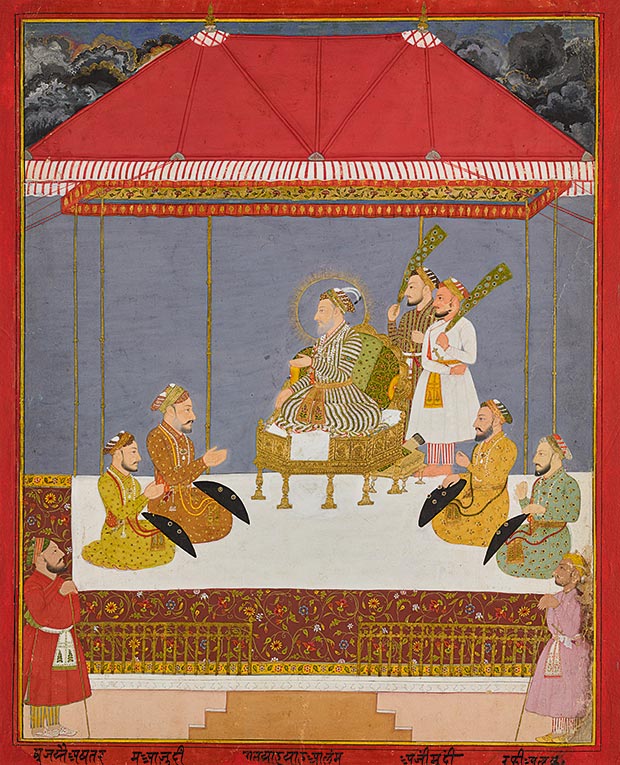 The Mughal Emperor Bahadur Shah with four of his sons, North India, Rajasthan, Mewar, circa 1710-20 / >
The Mughal Emperor Bahadur Shah with four of his sons, North India, Rajasthan, Mewar, circa 1710-20 / >
A rare and important Ottoman silk and metal-thread brocade panel (Kemha), Turkey, early 17th century (est. £60,000-80,000)
_Turkey_17th-century.jpg) L_A rare and important Ottoman silk and metal-thread brocade panel (Kemha), Turkey, early 17th century / R_detail / Courtesy of Sotheby's
L_A rare and important Ottoman silk and metal-thread brocade panel (Kemha), Turkey, early 17th century / R_detail / Courtesy of Sotheby'sA Safavid blue and white pottery dish depicting a lion, Persia, 17th century (est. £8,000-12,000)
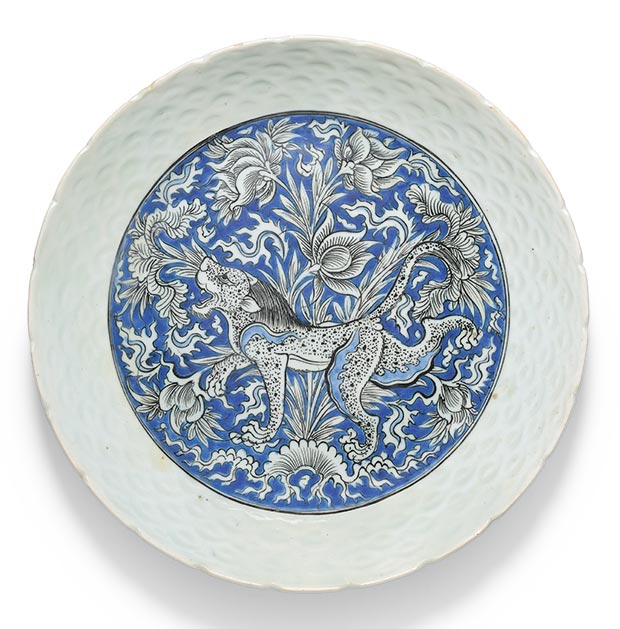 A Safavid blue and white pottery dish depicting a lion, Persia, 17th century / Courtesy of Sotheby's
A Safavid blue and white pottery dish depicting a lion, Persia, 17th century / Courtesy of Sotheby's
Comments
Add a comment